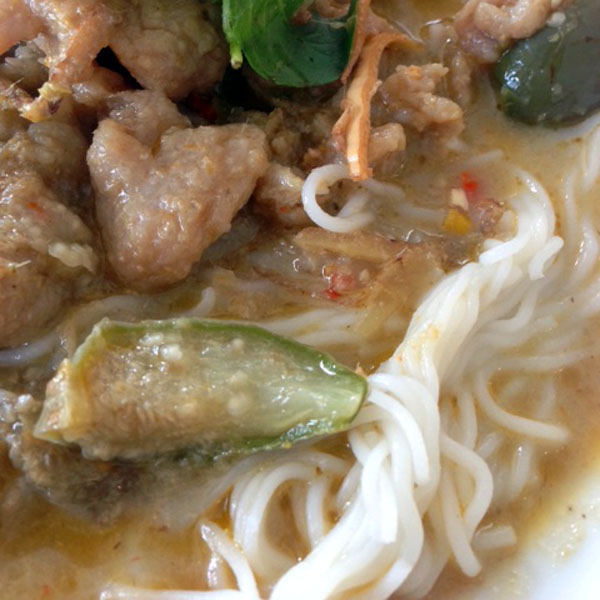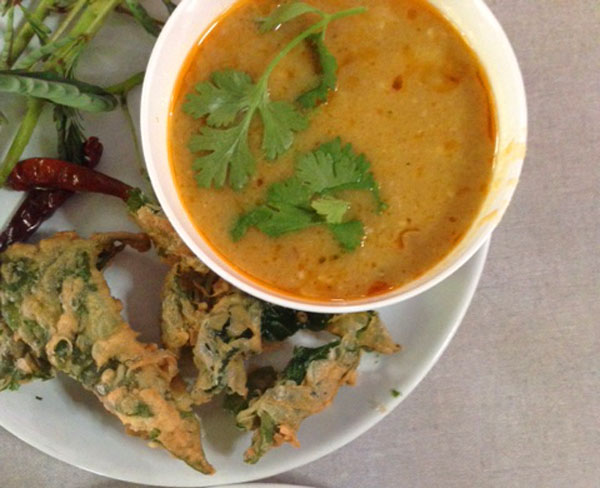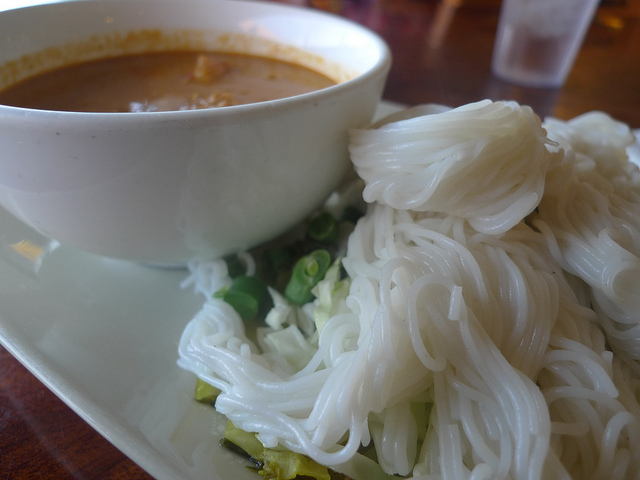Much is made of how rice forms the base on which all of Thai cuisine is built. After all, few people miss the fact that the Thai words for “food” (khao) and “rice” (again, khao) are the same. While rice is obviously what people think of when they think of Thai food, a lot of the culinary heavy lifting usually earmarked for rice – as the blank counterpoint to the zigs and zags of a curry, or as the sop to the fiery god of a chili-laden Thai salad – is also performed by rice’s uncelebrated cousin, kanom jeen.
Contrary to what the most rudimentary knowledge of Thai (mine) would suggest, kanom jeen does not actually mean “Chinese candy.” Instead, these fermented rice noodles – often called vermicelli on Bangkok menus – are said to have come from the Mon, a Burmese ethnic group whose history in central Thailand predates that of the Thais themselves. And of course there are similar versions of these noodles in Vietnam, China and Cambodia where, as in Thailand, the noodles are always the backup singer but never the star.
But the use of these noodles is more widespread than the typical Thai focus on rice would suggest. In the South, kanom jeen threatens to unseat rice as the staple starch, forming the centerpiece to the roadside “curry bars” that serve as the favored breakfast spot for most Thai Southerners. Here, diners are automatically given a bowl of noodles by a woman who invariably goes by the name of “Auntie” and charges by the number of curries ladled onto each plate. These roadside buffets are echoed in Bangkok by the khao gab gaeng (“rice and curry”) places that sprout up along Silom Road toward sundown and are betrayed by their wealth of condiments – cut-up this and that, pickled everything – on each waiting table.
In the Northeast (Isarn), kai kata (egg in a pan) is the preferred breakfast. But Northeastern Thais do their thing with kanom jeen too, mixing it with grated papaya, tomato, possibly mango, definitely fermented Thai anchovy, a crapload of chilies and maybe even a snail or two to create the som tam mua (“confused grated salad”) or som tam pa (“jungle grated salad”) favored by all Isarners who truly love their som tam. The addition of kanom jeen to the region’s most famous salad may be a relatively recent innovation. In any case it has spread in popularity enough that even Bangkokians who typically shy away from funky stuff like fermented anchovy and pickled crabs can get the kanom jeen-ed up version at the Suan Phlu market (across from the entrance to Suan Phlu Soi 8).
In Northern Thailand, where Chinese culinary influence is most prevalent, kanom jeen is a matter of course, but only with certain things. My favorite is as the backdrop to the chili bomb Bolognese that is nam ngiew, a porky stew spiked with tomatoes, dried chilies, fermented soybeans, slippery cubes of blood and spiky dried ngiew blossoms. With the required toppings of deep-fried garlic, pickled mustard greens, fresh bean sprouts, cilantro, scallions and a sliver of lime, this dish is the best Thai dish I can think of, and available at the Northern Thai restaurant Maan Muang in Sammakorn Village off Ramkhamhaeng Road.
My absolute favorite expression of kanom jeen love may come from the ladies at Sanguansri, however. Set near the entrance to Wireless Road between the Okura and Plaza Athenee hotels, this decades-old Thai lunch place remains so popular, the landlord allows it to keep its prime real estate spot at a reduced rent. The restaurant is now owned by the servers who have toiled there since its beginning, which may explain why the servers are almost all in their 60s and 70s, and not afraid to be a little crabby when the lunch rush is in full swing. That doesn’t detract from the deliciousness of its kanom jeen nam prik (“chili paste rice noodles”), a mishmash of a sweet-and-salty coconut milk-based curry starring kanom jeen, julienned banana blossoms and green beans, topped with both fresh and deep-fried greenery. This dish is difficult not to love.
If you do embark on a kanom jeen-centered culinary journey, some things to remember:
-
If you have leftover kanom jeen, don’t put it in the refrigerator. Somehow, this ruins it. You are supposed to keep it at room temperature.
-
Unlike Chinese-style soup noodles, these noodles are meant to be eaten with a fork and spoon.
-
Watch where you splash. I once splattered someone next to me with a little green curry, a fact they quickly brought to my attention in a very aggrieved tone of voice, twice. They were probably expecting some sort of song and dance of an apology, but once something like this happens, there really isn’t much left to do other than say sorry and move on. Please, dude, get on with your life.



Photos: Ron Dolette (top), Chawadee Nualkhair (bottom)
Editor’s Note: This article was originally published in February 2014. Since the information it contains is still relevant and useful, Coconuts editors have brought it back from the archives — rest assured, we’ve reviewed and updated it to make sure it will still serve you well, dear readers.




